How To Fish Flies With Spinning Gear: 2 Best Methods
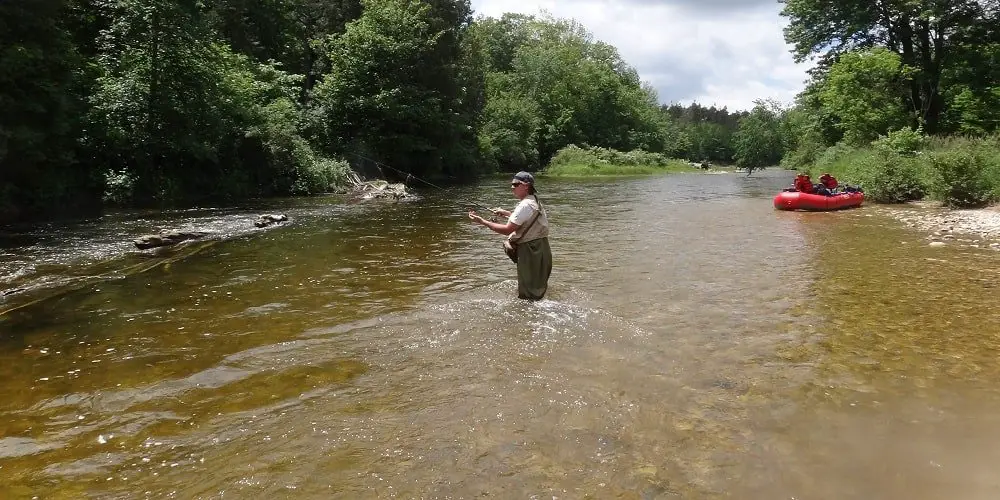
As a river guide that fishes for trout, steelhead, and salmon, I will tell you the two most effective ways to fish flies with spinning gear.
To fish flies using spinning gear, you will need at least a 7-foot rod, a spinning reel with a good line, and a proper leader setup. The most important thing when you use spinning gear to fish flies is the presentation. I use float fishing and bottom bouncing methods when I fish flies.
Flies are a great bait, and they catch a ton of trout and steelhead, there are four key things that I do to catch trout and steelhead consistently when using spinning gear.
How To Fish Flies With Spinning Gear
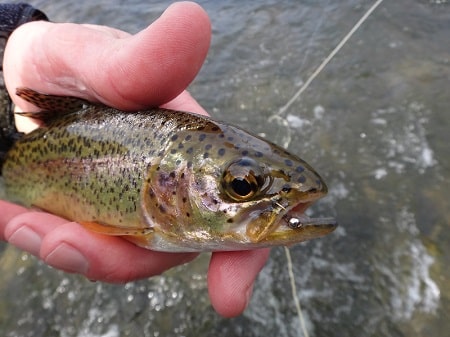
I treat flies like they are bait and I used the same bait fishing methods with these flies.
I also fish trout, steelhead, and salmon basically the same way and with the same methods, I just make sure my setup is specific to each of those species.
At times, I will use a single fly, a double fly rig, or a combination of bait and a fly, regulations permitting.
The best methods for fishing flies are Float Fishing, Bottom Bouncing, and Drift Fishing, and I will discuss these in more detail below.
Once you have figured out the best method, you need to be sure you have the right gear and use have an effective setup for the method you want to use.
Lucky for you, I cover all of that on this website and share effective guide setups and flies.
After your gear and setup are good and you have decided on the method you want to try, the next step is to choose effective flies. FYI, Not all flies are good!
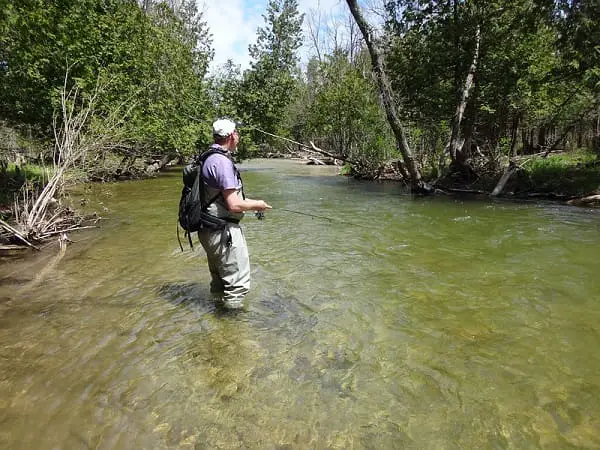
With flies, you want to be sure you are using productive flies, ones that work for the time of year, the type of conditions, the season, and the fish species you are fishing for.
Often, the same flies that work for one species of trout will work for another, and they will likely work for salmon and steelhead, too. However, not all flies are effective.
I remember doing a river raft guide trip along a private stretch of river and came up to a bend and there was a guy standing there trying to catch steelhead with a fly rod. As I approached, I saw it was the landowner, and I knew him.
He had been seeing how many fish we were catching near his house, so he went out and bought a full fly fishing setup and waders and some flies and started trying on his own.
He told me he was out for many days and had not caught a single steelhead yet, however, nearly every day my clients were catching 3 to 6 steelhead through his stretch of river.
I glanced at his fly and his setup and knew right away that even if he was fishing it perfectly, he still would not be catching fish with the fly he had on his line.
The fly you use can be a critical part of your success, and there are seasonal flies that just won’t work out of season. However, there are also flies that will work 90% of the time regardless of the time of year, the conditions, or the species of fish.
The Best Flies
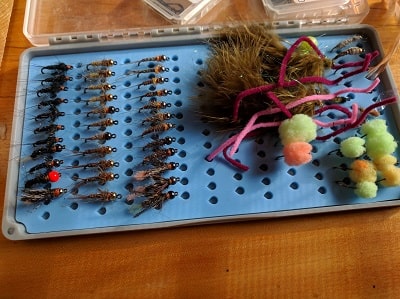
Picking and using good flies is really important.
Flies are imitations of aquatic insects or other insects found along the banks of the river. I fly could also be a bee, a beetle, or an ant. Trout will eat just about anything that falls into the river and floats past them.
Almost all trout and steelhead living in rivers will eat flies, and for many river trout, these small aquatic insects are their primary food source.
This makes flies a good choice for trout anglers.
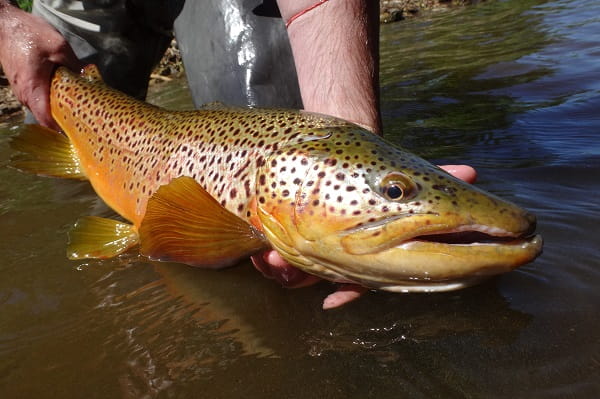
Despite what some other websites will tell you, even large trout will eat small flies, especially if there are enough small flies to fill them up.
I even catch lots of big steelhead and salmon on flies which shows that big fish will eat small things like flies.
Flies for trout and steelhead can be small or large. Flies can imitate small aquatic insects, but they can also imitate fish eggs, minnows, leeches, crayfish, frogs, and even mice.
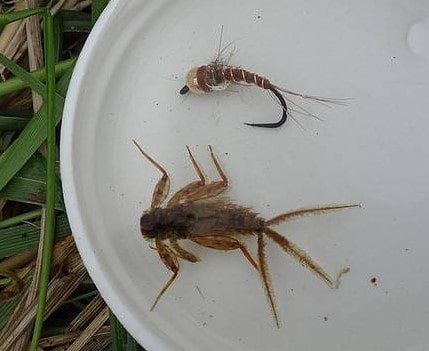
The best flies to fish with spinning gear are called nymphs which are subsurface insects.
Nymphs live below the rocks and are very abundant in many rivers, and both trout and steelhead recognize them as food.
Nymphs can come in many shapes, sizes, and colors. Brown and black imitation flies are always a good choice.
To some anglers, a nymph can also be a worm pattern, an egg pattern, even a sunken beetle, or just about anything that might fall into the river and then drift along under the surface.
To fish a nymph effectively, you will need to either float fish with them or bottom bounce with them, which I will discuss below.
My most used nymphs for trout are size 14 and size 16, and for steelhead or salmon, I will use size 8 through size 12.
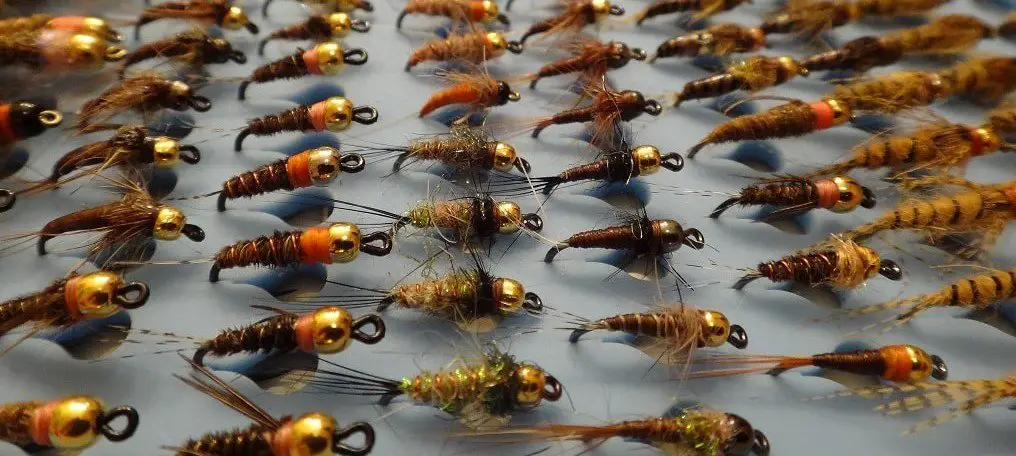
I use a lot of nymphs with bead heads when fishing for trout and steelhead because they seem to attract the fish more.
If I had to choose between a non-bead head nymph or a bead head nymph, I would choose the one with the bead most of the time. The bead also helps get the fly into the strike zone, which really improves your catch rate.
- Pheasant tail nymph – One of the best nymphs ever invented.
- Stonefly nymph – Good for trout and steelhead.
- Mayfly Nymph – Most rivers have mayflies, so a good mayfly pattern is a must.
- Caddis Larva – Some rivers have a lot of Caddis, and these are good to have in your fly box.
- Hares Ear Nymph – One of my all-time favorite general-purpose nymphs.
- Prince nymph – An attractor pattern every trout and steelhead angler should have.
- Czech Nymphs – A Caddis fly imitation – Czech nymphs are heavier and get down fast.
- Worm Pattern – My favorite colors are pink, brown, and red.
- Egg Fly Pattern – All trout, steelhead, and salmon eat eggs, and eggs can be the most effective bait at certain times of the year.
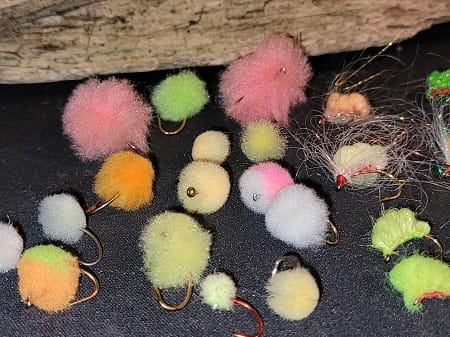
Check out:
Using A Float To Fish With Flies
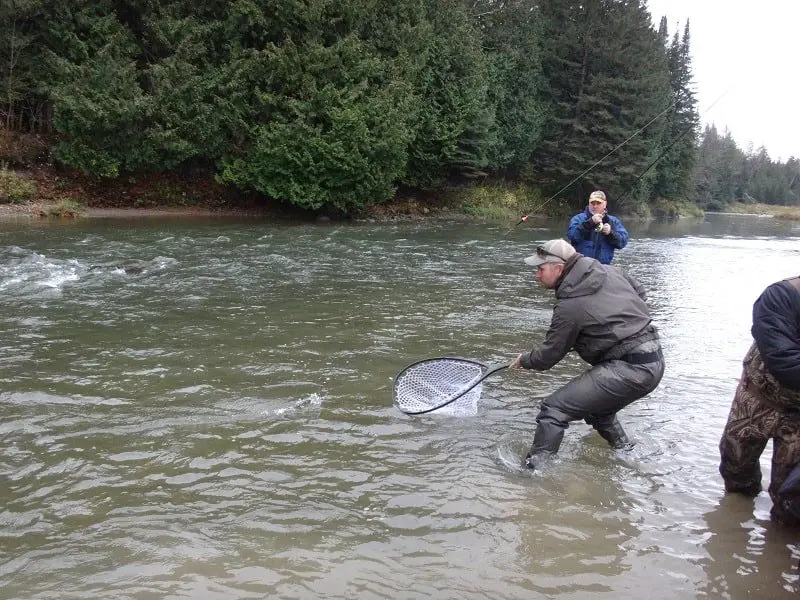
Using a float, which is also known to some people as a bobber, is the best method to present a fly when fishing spots that are over three feet deep.
If the river is less than three feet deep the best method is the bottom bounce method.
I use floats all the time when I fish for steelhead and salmon, as well as when fishing for trout. If you use the right floats combined with my float fishing leader set-up and then get a great presentation you will start catching more trout and steelhead.
Using the right leader strength and setting it up properly is really important if you want to catch more trout and steelhead. I also discuss this on my best leaders page.
Float fishing in rivers with flies is no different than float fishing with other baits. If you are interested in how I float fish, how I set up my leader, and what size leaders and hooks I use, go to my page How To Float Fish For Trout.
Using the right float can make a big difference check out my page on the 5 Best Floats.
Fish Flies Using Bottom Bouncing
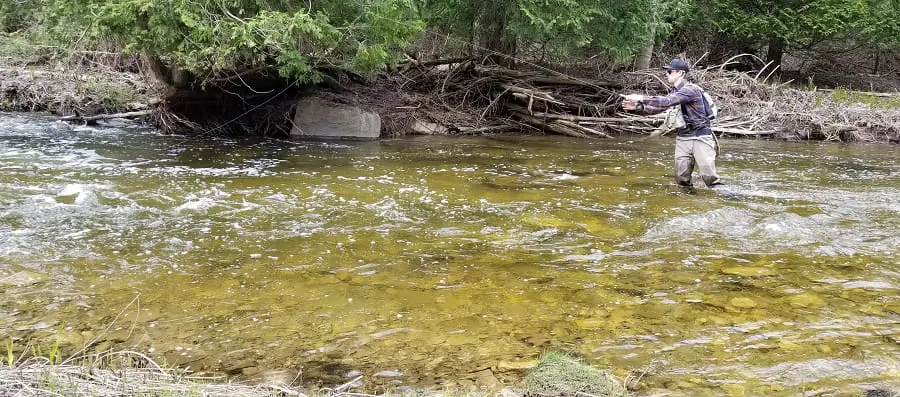
Bottom bouncing is the best way to fish flies in shallow and faster water. You can also bottom bounce in all types of water up to 20 feet. I bottom bounce with Spinning rods, Centerpin Rods, and Fly rods.
Bottom bouncing can be equally effective for trout, steelhead, and salmon in rivers, but only if you know how to do it well.
Bottom bounce can be extremely effective, and if you use my advanced bottom bouncing method, it will allow you to easily fish 12 inches of water or 8 feet of water without needing to make any adjustments. Check out my page, Bottom Bouncing – 5 Proven Guide Tips For More Fish
Other non-fly fishing methods you can use flies with include:
Covering The Water
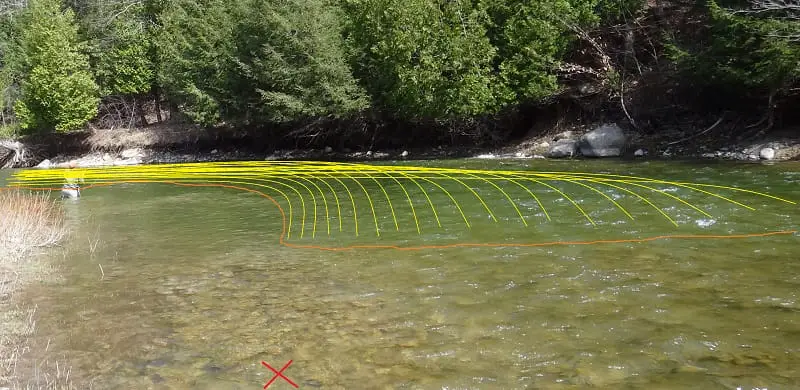
When fishing any type of water with a float, I will always cover the spot from the top of the spot down to the tail of the spot. I start at the top of the pool at the first drop.
I will almost always start my drifts in the area that should be the most productive, or that should hold the most feeding fish. This could be a bubble line, a current seam, or a deep slot. This is where reading the water well is important.
I will then spread the float drifts out systematically to cover the entire spot from the inside out.
And I would cover potential snag areas or hard-to-get areas last.
Covering the water well is critical to success for trout, steelhead, and salmon. For more information on covering the water, check out Effectively Covering The Water When Float Fishing.
Best Spinning Rods To Use For Trout.
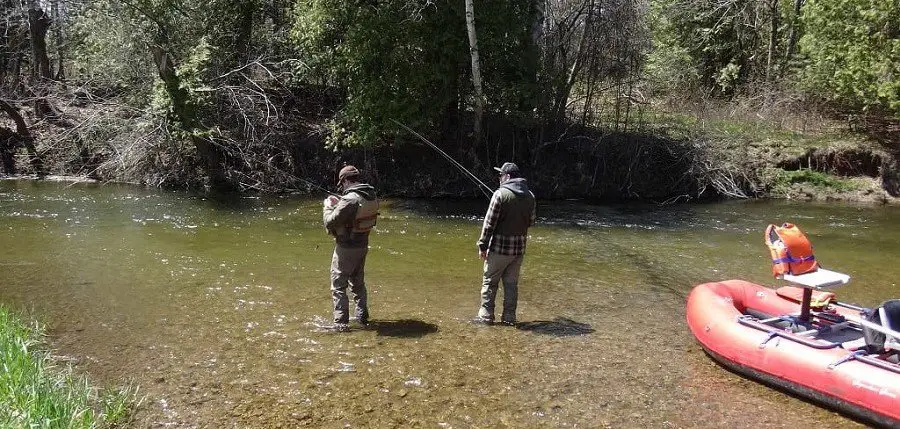
While you could fish flies for trout with a general-purpose six or 7-foot fishing rod, a longer rod that is designed for river fishing is often better because the longer rod provides extra height off the water, which allows you to keep your line up and off the water during a drift and that allows you to control your presentation better.
The longer rod also acts as a better shock absorber when fishing for trout on light leaders.
I might use a 7-foot rod in very small creeks that are less than 6 feet wide but for most rivers and creeks over 6 feet wide, I prefer a rod over 8 feet long. My go-to rod size on trout rivers over 20 feet is a 12-foot rod, but a 9 to 11-foot rod will work too.
I have an entire page on the best float rods with a chart that will help you choose the best rods for the type of river and type of fish you will be fishing. Check out Best River Fishing Trout Rods.
If you are interested in all the best gear for river fishing check out this page called The Best River Fishing Products.
That concludes my article; I hope it helps you fish better with spinning gear better.
If you have any questions, or you have any ideas or tips about fishing with flies with spinning gear just leave them in the comments section below.
Tight Lines
Graham
Resources:

This is unbelievable! My phone is spying on me. I was just talking to a friend about my way of doing this. I use the float method. But I also use a piece of fly line about 2 to 3 ft long from float to my tippet. Then a light line leader about 3 ft long. This keeps the bobber from spooking the fish. Now I haven’t done any trout fishing yet but I really want to. Mostly bass and bluegill with small minnow flies, or floating frogs and bugs. I also use a 9-ft crappie rod. Thank you for this article, because most of my fishing friends think that I’m crazy for even thinking about doing something like this without a fly rod setup. But I’ve been extremely successful with it. Write on! Oh and Fish on!
Hey Daryl,
The way I look at it, is if it works well, who cares what others think.. Sounds like you are a guy that can really think outside the box.
Good luck with the trout
Graham